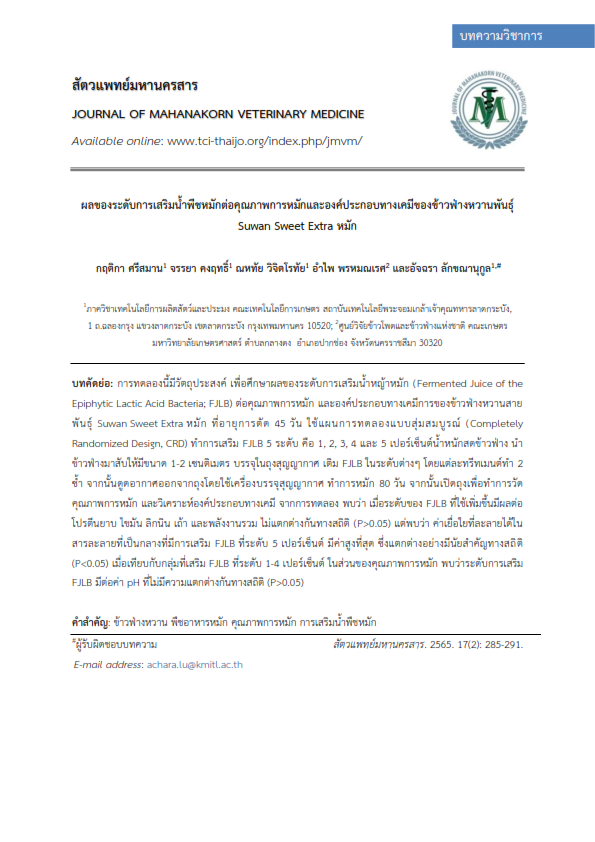Effects of the fermented juice of epiphytic lactic acid bacteria (FJLB) on fermentation characteristics and chemical composition of Suwan Sweet Extra sorghum silages
Main Article Content
Abstract
การทดลองนี้มีวัตถุประสงค์ เพื่อศึกษาผลของระดับการเสริมน้ำหญ้าหมัก (Fermented Juice of the Epiphytic Lactic Acid Bacteria; FJLB) ต่อคุณภาพการหมัก และองค์ประกอบทางเคมีการของข้าวฟ่างหวานสายพันธุ์ Suwan Sweet Extra หมัก ที่อายุการตัด 45 วัน ใช้แผนการทดลองแบบสุ่มสมบูรณ์ (Completely Randomized Design, CRD) ทำการเสริม FJLB 5 ระดับ คือ 1, 2, 3, 4 และ 5 เปอร์เซ็นต์น้ำหนักสดข้าวฟ่าง นำข้าวฟ่างมาสับให้มีขนาด 1-2 เซนติเมตร บรรจุในถุงสุญญากาศ เติม FJLB ในระดับต่างๆ โดยแต่ละทรีทเมนต์ทำ 2 ซ้ำ จากนั้นดูดอากาศออกจากถุงโดยใช้เครื่องบรรจุสุญญากาศ ทำการหมัก 80 วัน จากนั้นเปิดถุงเพื่อทำการวัดคุณภาพการหมัก และวิเคราะห์องค์ประกอบทางเคมี จากการทดลอง พบว่า เมื่อระดับของ FJLB ที่ใช้เพิ่มขึ้นมีผลต่อโปรตีนยาบ ไขมัน ลิกนิน เถ้า และพลังงานรวม ไม่แตกต่างกันทางสถิติ (P>0.05) แต่พบว่า ค่าเยื่อใยที่ละลายได้ในสารละลายที่เป็นกลางที่มีการเสริม FJLB ที่ระดับ 5 เปอร์เซ็นต์ มีค่าสูงที่สุด ซึ่งแตกต่างอย่างมีนัยสำคัญทางสถิติ (P<0.05) เมื่อเทียบกับกลุ่มที่เสริม FJLB ที่ระดับ 1-4 เปอร์เซ็นต์ ในส่วนของคุณภาพการหมัก พบว่าระดับการเสริม FJLB มีต่อค่า pH ที่ไม่มีความแตกต่างกันทางสถิติ (P>0.05)
Article Details

This work is licensed under a Creative Commons Attribution-NonCommercial-NoDerivatives 4.0 International License.
References
เสมอใจ บุรีนอก. 2554. การใช้แบคทีเรียกรดแลคติคในน้ำพืชหมักเป็นสารเสริมชนิดใหม่ในพืชหมักเขตร้อน. แก่นเกษตร 39: 85-98.
Al-Beiruty, R.Z.A. Cheyed, S.H. and Hashim, M.H. 2020. Hazards of toxic hydrocyanic acid (HCN) in sorghum and ways to control it. บทวิจารณ์ Plant Archives 20(1):2726-2731.
Barnhart, S. and Dewell, G. 2011. Prussic Acid Poisoning Potential in Frosted Forages. https://crops.extension.iastate.edu/cropnews/2011/09/prussic-acid-poisoning-potential-frosted-forages . 9 February 2022.
Bureenok, S., Yuangklang, C., Vasupen, K., Schonewille, J.T. and Kawamoto, Y.. 2012. The Effects of Additives in Napier Grass Silages on Chemical Composition, Feed Intake, Nutrient Digestibility and Rumen Fermentation. Asian-Australas J Anim Sci. 25(9): 1248–1254.
Carvalho, B. F., Ávila, C. L. S., Pinto, J. C., Neri, J. and Schwana, R. F. 2014. Microbiological and chemical profile of sugar cane silage fermentation inoculated with wild strains of lactic acid bacteria. Anim. Feed Sci. 195: 1-13.
Cattani, M., Guzzo, N., Mantovani, R. and Bailoni, L. 2017. Effects of total replacement of corn silage with sorghum silage on milk yield, composition, and quality. https://link.springer.com/article/10.1186/s40104-017-0146-8.
Khosravi, M., Rouzbehan, Y., Rezaei, M. and Rezaei, J. 2018. Total replacement of corn silage Kenji Hosoda, Bayaru Eruden, Hiroki Matsuyama, Shigeru Shioya. 2009. Silage Fermentative Quality and Characteristics of Anthocyanin Stability in Anthocyanin-rich Corn (Zea mays L.). Ruminant Nutrition and Forage Utilization. Asian-Australasian Journal of Animal Sciences 2009;22(4): 528-533. https://www.sciencedirect.com/science/article/pii/S0022030218309433#bib61
Kidd, T. 2015. 4 keys to managing forage sorghum silage. (Available Source) : https://www.progressiveforage.com/forage-types/silage/4-keys-to-managing-forage-sorghum-silage . 20 February 2022.
Ledbetter, K. 2019. Harvest management can enhance sorghum silage value. (Available Source): https://agrilifetoday.tamu.edu/2019/09/20/harvest-management-can-enhance-sorghum-silage-value/ . 20 February 2022.
Llewellyn, D. and Norberg, S. 2014. Prussic Acid Poisoning in Livestock. (Available Source) : https://s3.wp.wsu.edu/uploads/sites/2071/2014/01/Prussic-Acid-Poisoning-in-Livestock.pdf . 20 February 2022.
McDonald, P., Henderson, A.R. and Heron, S.J.E. 1991. The biochemistry of silage 2nd Ed. Chalombe Publications, Marlow, England.
Ndilorenzo, N. 2020. Sorghum Silage – A Cost-effective Alternative for Backgrounding Weaned Cattle. https://nwdistrict.ifas.ufl.edu/phag/2020/06/19/sorghum-silage-a-cost-effective-alternative-for-backgrounding-weaned-cattle/
Oten, M. 2017. The Effects of Different Sowing Time and Harvesting Height on Hydrocyanic Acid Content in Some Silage Sorghum (Sorghum bicolor L.) Varieties. Turkish Journal of Field Crops 22(2): 211-217.
Santos, E., Silva, T.C.D., Macedo, C.H.O. and Campos, F. 2013. Lactic Acid Bacteria in Tropical Grass Silages. Lactic Acid Bacteria - R & D for Food, Health and Livestock Purposes (pp. 335-362).
Sarah E. Lyons, Quirine M.Ketterings, Gregory S.Godwin, Debbie J.Cherney, Jerome H.Cherney, Michael E.Van Amburgh, John J.Meisinger, Tom F.Kilcer. 2019. Optimal harvest timing for brown midrib forage sorghum yield, nutritive value, and ration performance. Journal of Dairy Science. Volume 102, Issue 8, Pages 7134-7149.
Stenhouse, J. W. and Tippayaruk, J.L. 1996. Sorghum bicolor (L.) Moench. pp. 130-136. In Grubben, G. J. H. and S. Partohardjono, eds. Plant Resources of South–East Asia No. 10: Cereals . PROSEA Foundation, Indonesia.
Taylor, J. R. N., 2019. Chapter 1 - Sorghum and Millets: Taxonomy, History, Distribution, and Production. Sorghum and Millets (Second Edition). p.1-21.
Weinberg, Z.G. and Muck, R. E. 1996. New trends and opportunities in the development and use of inoculants for silage. FEMS Microbiology Reviews, 19: 53-68.
Yanti, Y., Riyanto, J., Dewanti, R., Cahyadi, M., Wati, A. K. and Pawestri, W. 2021. The fermentation quality of complete feed with FJLB silage additive from tropical grass. Earth and Environmental Science 824.


